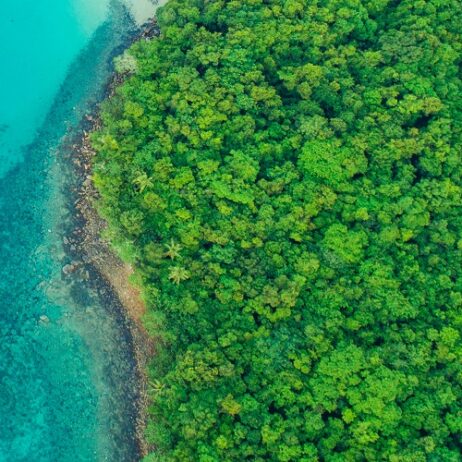
Nick Hollis completed his Atlantic Row in 50 days. Credit: Total Active Hub/721 Challenge
Nick Hollis has summited all seven of our planet’s continents highest mountains, skied across the South Pole and — just recently — rowed across the fierce Atlantic Ocean. This is all part of his awe-inspiring commitment to bring awareness to the climate crisis and biodiversity loss and raise funds for WLT’s partners tackling these issues. Named the ‘721 Challenge – a race against climate change’, Nick has gone to extreme lengths in aid of our living planet as part of an incredible world record attempt.
In the latest stage of his epic challenge, he tested his formidable endurance in the ‘World’s Toughest Row’. Beginning in the Canary Islands, Nick arrived in Antigua on 2 February 2024, disembarking from his boat after 50 days of rowing solo. Following some well-deserved rest, and whilst preparing for his final hurdle of skiing to the North Pole, Nick spared some time to share some of his 3,000 miles worth of stories with us.
WLT: Preparation seems to have been a fundamental part of your 721 Challenge. How did you get ready for rowing the Atlantic?
Nick: As a complete newbie to ocean rowing, the Atlantic Row was by far the most demanding 721 Challenge event in terms of planning and preparation. After sourcing and preparing Kraken — the vessel that would take me across the ocean — I had to complete four different training courses including ones on navigation and first aid. I also had to have 500 hours of ocean rowing experience in British waters. I really threw myself into the deep end — learning to row efficiently for extended time periods. I did most of this training alone, but occasionally was joined in the boat by my Border Collie Tinker. All in all, I did six months of intense physical preparation.
The endless deadlines were highly challenging and sometimes pushed me to my limit. I can’t recall a single weekend during this period where I wasn’t training or working on the boat. On weekdays, I usually finished work in the early hours of the morning and this exhausting schedule continued until the morning of the race. However, as soon as the starting gun fired and I rowed out of San Sebastian harbour in La Gomera, the sense of relief felt incredible. Three years of pressure melted away, only to be replaced by a huge grin and a familiar feeling that something rather extraordinary was about to take place.
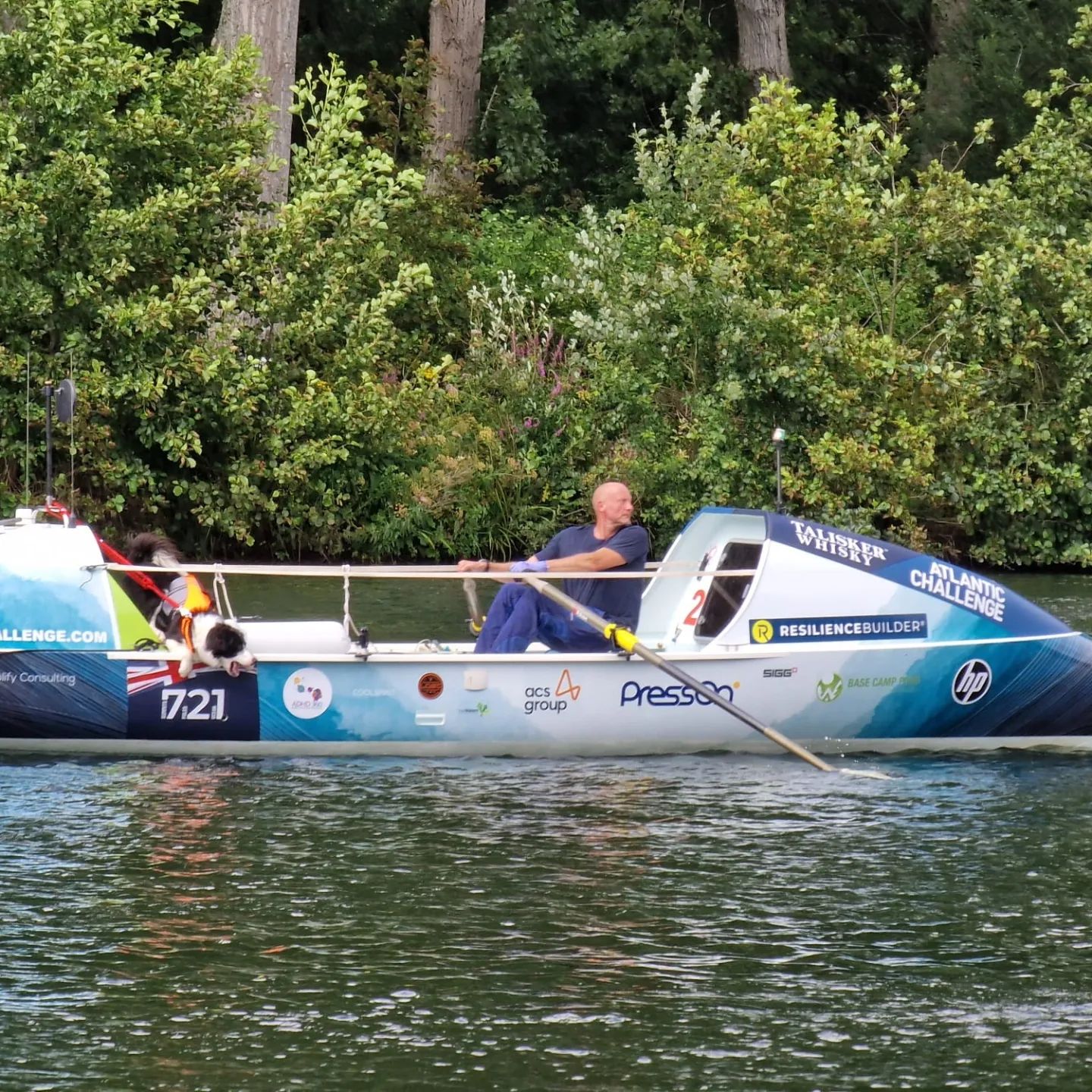
Nick’ Border Collie Tinker joined him on several training sessions on the water. Credit: Nick Hollis/721 Challenge
WLT: The ocean is a powerful life force – how did you find navigating from La Gomera to Antigua?
Nick: When you look at a map of the Atlantic Ocean, the logical strategy would be to follow a straight line from La Gomera to Antigua. However, the map doesn’t show the invisible weather systems traversing the Atlantic in an Easterly direction. Unfortunately, I learned this the hard way. During the first eight days of the row I encountered strong gale force winds, pushing me into a nasty low-pressure system. For seven days I battled with the weather, rowing for over 120 hours to avoid being sucked into the weather system which would have likely taken me toward Ireland and ended my row. I was utterly exhausted by the end of that week and Kraken had a snapped daggerboard — an essential piece of equipment prevents the boat from moving sideways. It was enough of a wake-up call; I needed an expert navigator, so someone was recruited to the ground team. Thanks to their brilliant work, I was able to navigate through several more challenging weather systems until I got to Antigua.
WLT: What did a typical routine look like on the boat?
Nick: Interestingly, before the row started, I planned to row for two hours on and two hours off per day. However, as a solo rower I quickly realised this wouldn’t work. Nature dictates the schedule, not me. I sometimes needed to row for 22 out of 24 hours just to avoid moving backwards! As I moved closer to Antigua, the midday heat became unbearable, and I discovered I felt and performed much better when rowing at night.
To fuel all of this, I aimed to consume around 6,500 calories per day. Most of my food came as snacks like flapjacks, energy bars, trail mix, etc. which are easy to eat while rowing. I consumed many meal replacement drinks, electrolytes, and energy powders to keep me fuelled. When the conditions permitted, I would also boil water and rehydrate a freeze-dried meal.
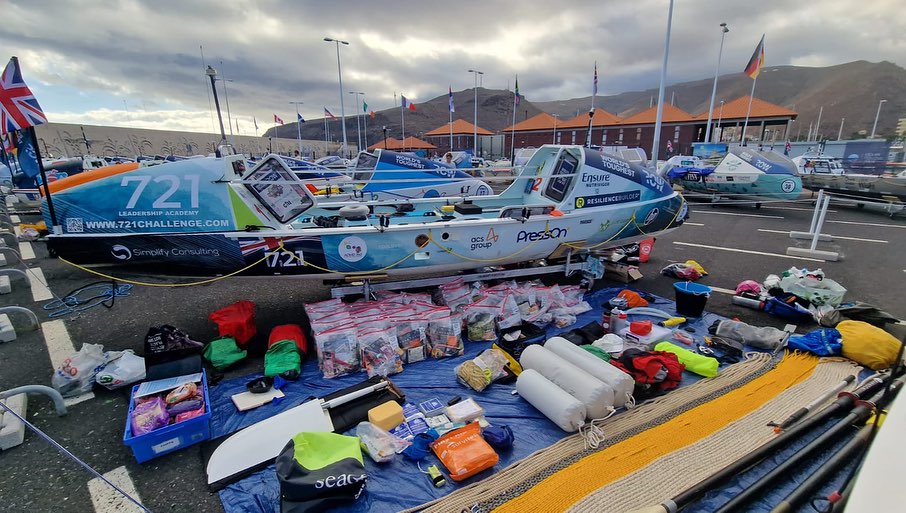
Nick’s boat, Kraken, after having his kit and supplies inspected by the World’s Toughest Row safety team before the race. Credit: Nick Hollis/721 Challenge
WLT: In your 50 continuous days on a small boat at sea, did you get any sea sickness or changes to your physical condition?
Nick: Fortunately, I wasn’t too affected by seasickness, despite the sea conditions having been described by the World’s Toughest Row Safety Team as some of the most demanding in the race’s history. The only time I recall throwing up was after consuming a family-sized bag of jelly babies for breakfast… It’s not something I’ll be repeating anytime soon!
Interestingly, blisters (on my hands and bottom) and a sore back were the most physically challenging aspect of the row. I was also amazed to see my calf muscles disappear before my eyes — these are hardly used in rowing and quickly atrophy.
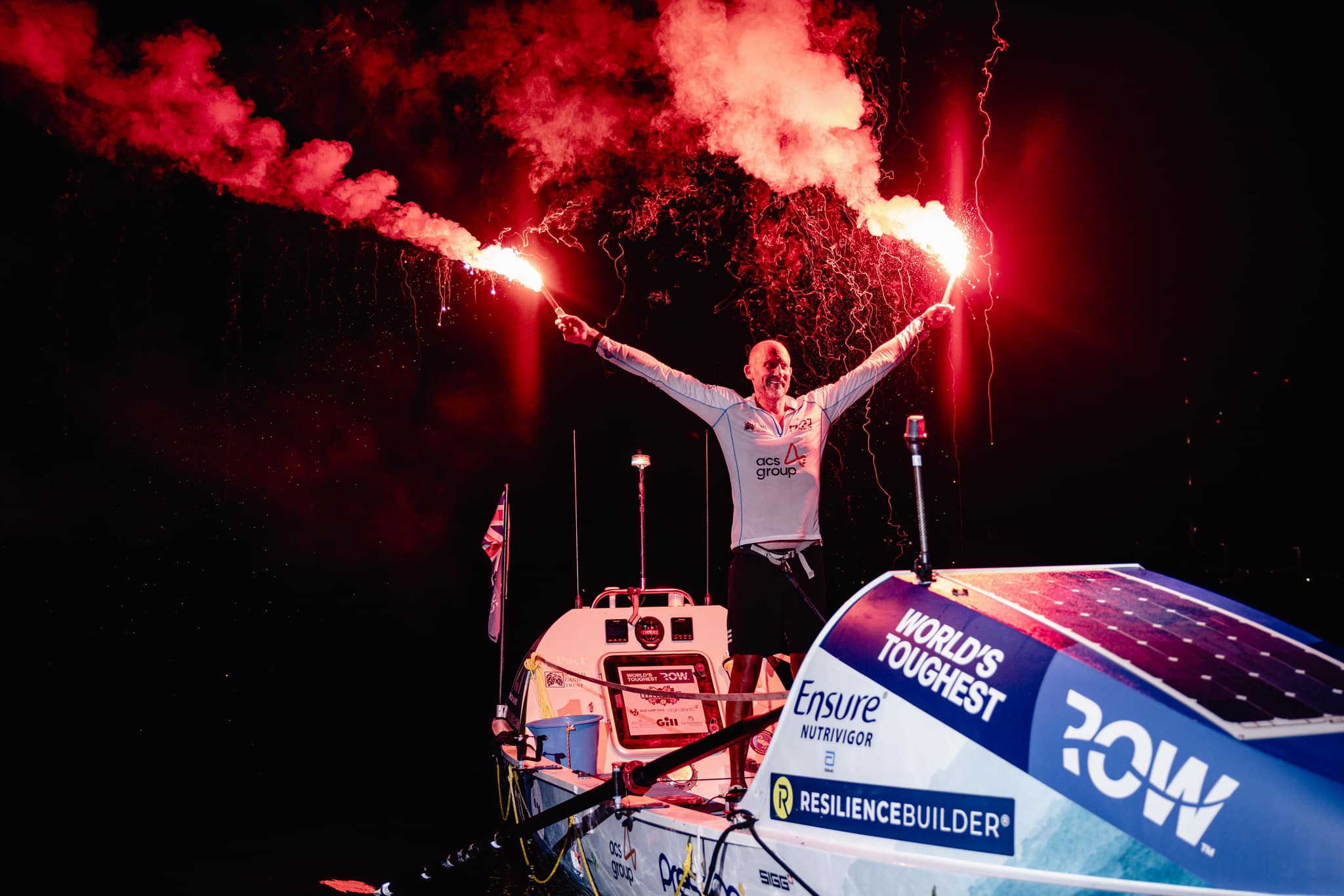
Nick was the 6th solo to arrive and the 27th boat to cross the World’s Toughest Row finish line in Antigua. Credit: World’s Toughest Row
WLT: Did the row create any emotional challenges for you?
Nick: The entire journey across the Atlantic was an emotional rollercoaster. The scariest moments of the race all occurred in the first week. The relentless storm conditions required total focus to keep Kraken upright. During this period, I capsized twice, and the huge waves frequently pinned Kraken on her side. I found that the distance I rowed each day particularly influenced my mood. Some days I had to put down the sea anchor (an underwater parachute which reduces drift) which was always a low point.
As a solo rower, sleep deprivation was a significant challenge and as the days passed, I found myself becoming increasingly fatigued, with hallucinations becoming a frequent occurrence – not ideal when operating in such a dangerous environment. However, despite rowing solo I didn’t feel particularly isolated. I carried a satellite phone and spoke regularly with the ground team about the weather and navigational strategy. I was even able to talk with my parents just after Christmas.
When the going got particularly tough, I would think about how far I’ve come with 721 Challenge and the fantastic work World Land Trust are doing around the world to ensure future generations have the opportunity to explore and enjoy the natural world.

Credit: World’s Toughest Row
WLT: Being so intimately close to the water must have led to memorable encounters with marine life, what did you see out there?
Nick: In complete contrast to my South Pole expedition, which was incredibly hostile and appeared devoid of life, the Atlantic Ocean was alive and brimming with activity. Some of the most memorable nature highlights involved whales, for example when I was lifted about 0.3 metres high by one and then slid off its colossal back. I was also blessed to have a pod of whales visit me, just metres from Kraken as well as seeing them breech at an impressively close range. Those moments will stay with me for the rest of my life. I also can’t forget the superbly graceful flying fish bouncing from wave to wave and which could cover enormous distances, as well as the breathtaking sunsets, sunrises and starlit skies.
The ocean life I encountered also included snails and barnacles which clung Kraken’s underside. Having thousands of these critters attached to the hull creates considerable drag, which can literally half the speed. I thus began a weekly ritual where I went into the water, swam under the boat with a windscreen scraper, and removed the barnacles and snails by hand. Taking around 90 minutes each time, it really tired me out. It was worth it though — I went much faster afterwards!
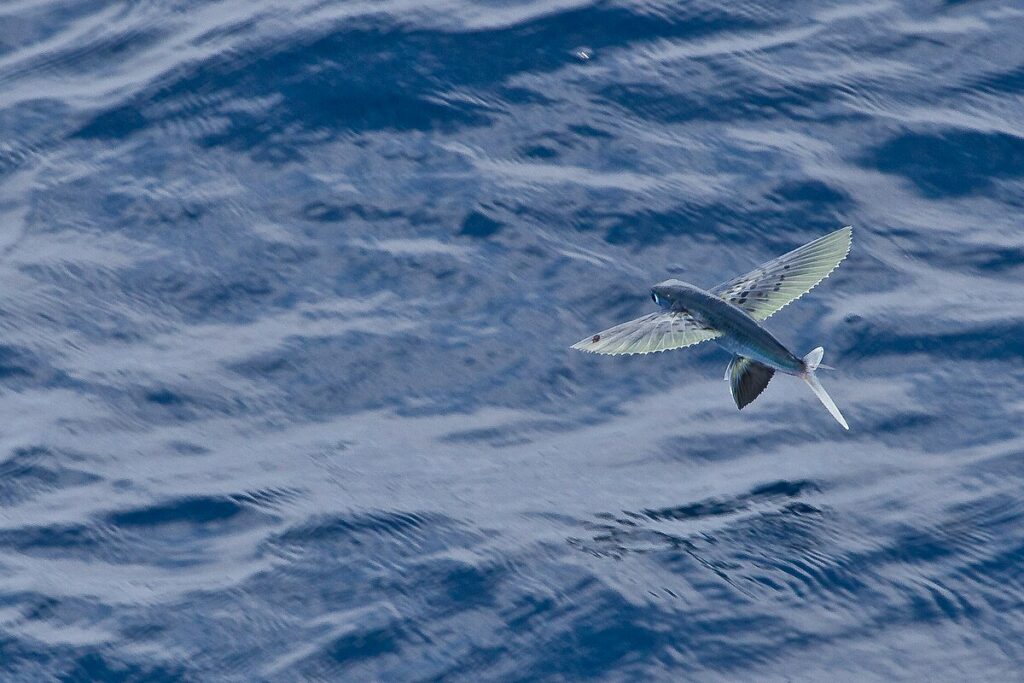
Flying fish (Exocoetidae) are a family of marine ray-finned fish found in the Atlantic and other oceans. Credit: Mike Prince/Wikimedia commons [CC-BY-2.0 DEED]
WLT: Did you learn something about yourself that you didn’t know before getting in the boat?
Nick: To this day, I’m still completely amazed by how little sleep the human body can get and still perform over an extended timeframe. Without a doubt, the row took me to a level of sleep deprivation I’d not previously experienced.
WLT: They must call it the World’s Toughest Row for a reason, would you do it again?
Nick: There’s no doubt World’s Toughest Row lived up to its name and reputation. I’m still in the reflection phase of the challenge but, if you asked me right now, I don’t think I’d ever do it again. It’s a bit risky for my liking.
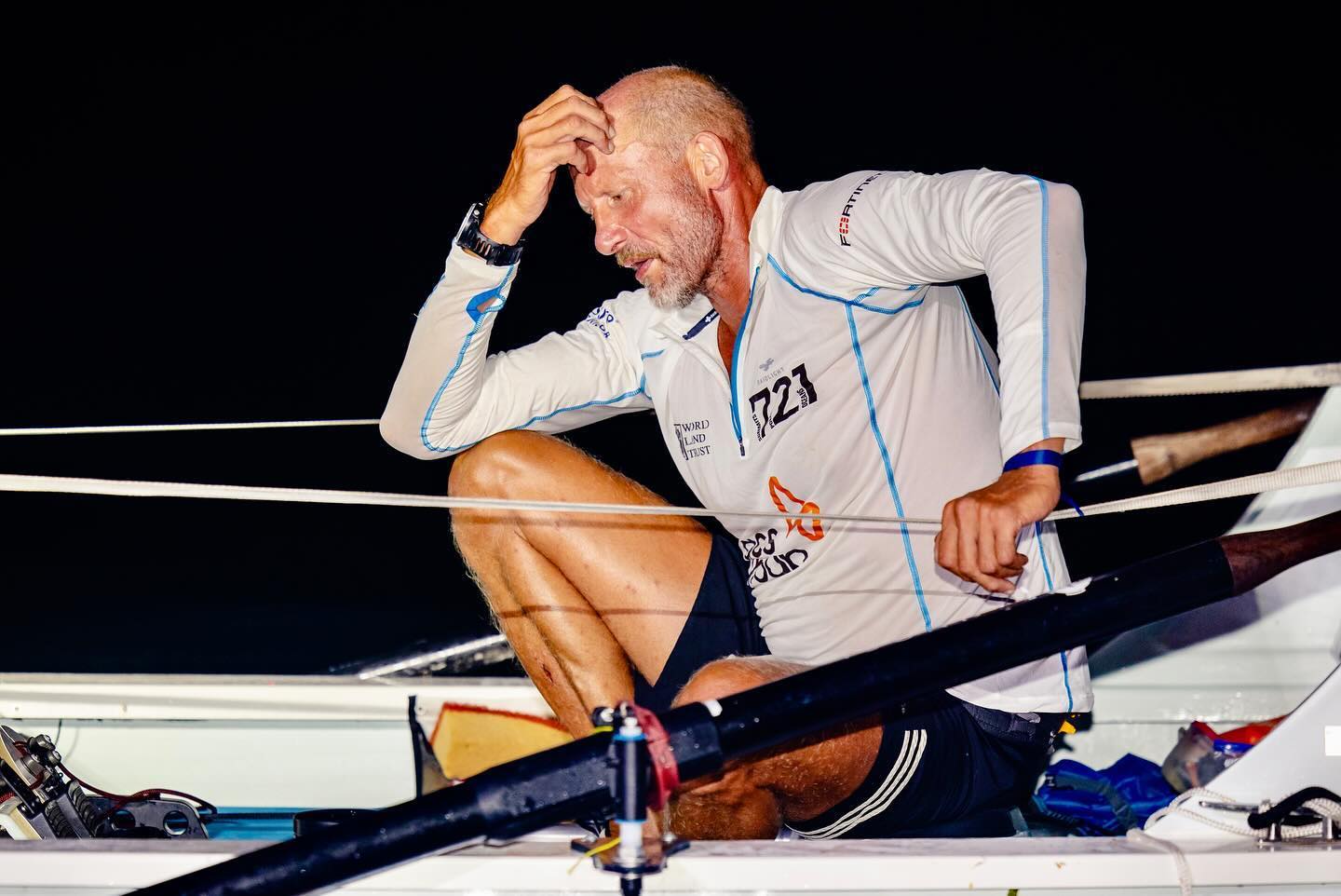
Credit: World’s Toughest Row
WLT: Why is supporting WLT so important to you personally?
Nick: From a young age, I have been most relaxed and content when immersed in nature. This was unquestionably a driving factor in my decision to work as an expedition leader. I was able to lead teams of people to some of the most beautiful places on earth. However, after 30 years of working and playing outdoors, I’ve seen firsthand the impact humans have on the planet and it’s heartbreaking. As the years passed, I felt an increasing sense of duty to do whatever I could to preserve the natural world for future generations to explore and enjoy. WLT make a tangible difference in this sense and — having seen and met members of WLT’s remarkable partner network — I’m confident no organisation in the world can do this better.
WLT: Whilst not necessarily doing an Atlantic row, for someone wanting to do a challenge to raise money for WLT, what advice would you give them?
Nick: Firstly, I would encourage them to learn as much as possible about WLT to understand the direct impact they will make by supporting them to give you long-term motivation. The next stage would be defining the challenge you want to attempt. From experience, I would encourage you to select or create a challenge slightly beyond your current capabilities. Simply knowing that success is not 100% guaranteed is highly motivating and focuses the mind. Once the challenge has been defined, a good next step is to work out all the barriers likely to get in your way and address them early by making an action plan to overcome them. Then it’s time to commit to achieving your goal by first announcing your intentions! This can involve publicising it on social media or booking a publicity event. Following this, it’s imperative to keep the momentum building… For me, the most effective way to do this is to think about whatever WLT project you are supporting and the difference you and the WLT team will make for our living planet and for future generations.
We are greatly inspired and proud of Nick for having dedicated the 721 Challenge to WLT and its mission to save land and species. Click here to find out more about Nick’s incredible achievements and to donate to his challenge.

